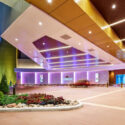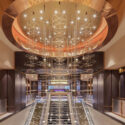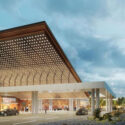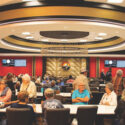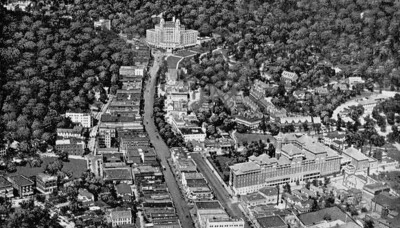 Hot Springs in 1925 included bathhouses on one side of Central Avenue and casinos on the other, all leading to the elegant Arlington Hotel at the top of the hill.
Hot Springs in 1925 included bathhouses on one side of Central Avenue and casinos on the other, all leading to the elegant Arlington Hotel at the top of the hill. Back in the day (1920 through the 1940s), pockets of semi-legal gambling existed in towns across the United States. Union City, New Jersey; Steubenville, Ohio; Covington, Kentucky; Biloxi, Mississippi; Cripple Creek, Colorado; Deadwood, South Dakota; and Tombstone, Arizona were just a handful of the dozens of towns that looked the other way when gambling took place within their borders. In most cases, local authorities got a cut of the profits, and the industry was very lucrative. Today, lots of these places again host fully legal gambling, which was historically part of their heritage.
That’s the case with Hot Springs, Arkansas. Recently, HBG Design completed a five-star hotel at Oaklawn Racing Casino Resort, home of one of the legal casinos recently approved by the state. It’s a beautiful hotel, with a full selection of non-gaming amenities, situated on the first turn of the famous racetrack, which dates back to Hot Springs’ gambling heyday.
The Mobster & the Mayor
Tourism was always a part of Hot Springs, from the days when Native Americans visited the valley to enjoy the town’s namesake hot springs. And prior to the Civil War, the baths that linked the hot springs were a popular destination for travelers across the U.S.
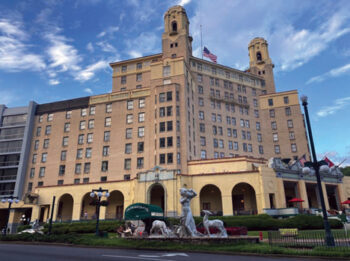
Today’s Arlington Hotel is faded and frayed.
A tourism slump following the Civil War brought the first vestiges of gambling to town, culminating in an 1899 gunfight between Hot Springs police and county sheriffs. Each side had backed a different gambling faction in town, and the shootout left three dead.
By the mid-1920s, a mobster named Owney Madden had moved from New York to Hot Springs, and controlled gambling through his Hotel Arkansas casino, supported by the town’s mayor, Leo P. McLaughlin. At the height of early gambling in Hot Springs, there were 10 major casinos and some smaller establishments in the city, along with the Oaklawn Racetrack. The track’s race meets drew the biggest volume of travel to the resort. Madden is credited with making Hot Springs the birthplace of the “wire,” which disseminated information among racetracks, thus allowing off-track betting.
Madden and McLaughlin fended off prosecution and legislative action for the next 20 years. Gambling continued to thrive in Hot Springs, until some GIs returning from World War II took on the McLaughlin political machine, and drove the activity from the city.
In the 1940s, Arkansas seriously considered legalizing gambling in Hot Springs, noting the rise of Reno and Las Vegas when gambling became legal in Nevada. But the move failed narrowly in the state Senate. One can only wonder what would have become of Hot Springs had the effort succeeded.
After a short revival of gambling during the administration of Governor Orval Faubus, the industry finally came to an end in 1967. That’s when new Governor Winthrop Rockefeller sent in a phalanx of state troopers to shut down the remaining casinos and clubs, and destroy all their gaming equipment. For the next 50 years, Arkansans could only legally wager at Oaklawn and Southland Greyhound Track outside Memphis. Then, in November 2018, Arkansas passed a constitutional amendment to permit casino gaming at Oaklawn, Southland, and two other locations in the state.
Central Revival

The elegant bathhouses exist today as part of the Hot Springs National Park.
Today, Oaklawn is a first-class casino and resort. But unfortunately, downtown Hot Springs is fraying around the edges. Bathhouse Row and the surrounding mountains are now part of the National Park system, but the stores, hotels and motels across the street on Central Avenue are hurting. The Vapors, the last casino built when gambling was still allowed, is now a sketchy nightclub. The formerly grand Arlington Hotel, summer home to mobsters like Al Capone in his day, is shabby and worn.
Imagine if you will that, instead of just Oaklawn, gambling was revived along Central Avenue, as in the mountain towns of Colorado and South Dakota. Those shuttered casinos could return to their former glory, and Hot Springs could become a true destination resort once again, with multiple tourist attractions. The city would truly be revived.
We can only dream.
For a fascinating read about Hot Springs in its glory days, check out The Vapors: A Southern Family, the New York Mob, and the Rise and Fall of Hot Springs, America’s Forgotten Capital of Vice by David Hill.



